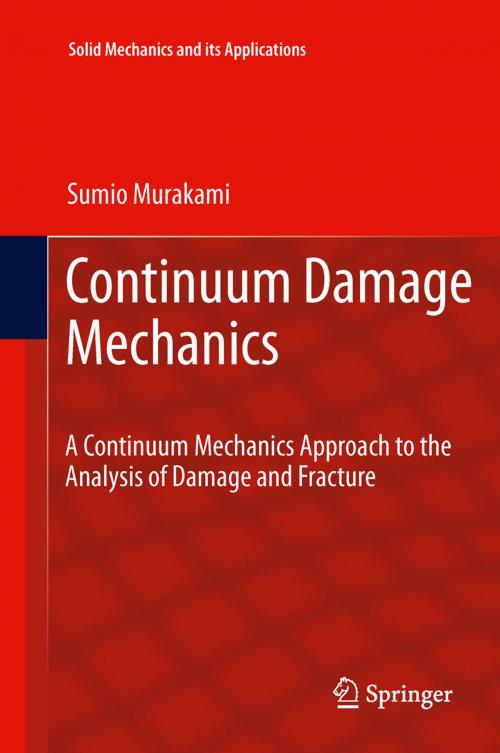Continuum Damage Mechanics
A Continuum Mechanics Approach to the Analysis of Damage and Fracture
Nonfiction, Science & Nature, Technology, Material Science, Science, Physics, Mechanics| Author: | Sumio Murakami | ISBN: | 9789400726666 |
| Publisher: | Springer Netherlands | Publication: | February 23, 2012 |
| Imprint: | Springer | Language: | English |
| Author: | Sumio Murakami |
| ISBN: | 9789400726666 |
| Publisher: | Springer Netherlands |
| Publication: | February 23, 2012 |
| Imprint: | Springer |
| Language: | English |
Recent developments in engineering and technology have brought about serious and enlarged demands for reliability, safety and economy in wide range of fields such as aeronautics, nuclear engineering, civil and structural engineering, automotive and production industry. This, in turn, has caused more interest in continuum damage mechanics and its engineering applications.
This book aims to give a concise overview of the current state of damage mechanics, and then to show the fascinating possibility of this promising branch of mechanics, and to provide researchers, engineers and graduate students with an intelligible and self-contained textbook.
The book consists of two parts and an appendix. Part I is concerned with the foundation of continuum damage mechanics. Basic concepts of material damage and the mechanical representation of damage state of various kinds are described in Chapters 1 and 2. In Chapters 3-5, irreversible thermodynamics, thermodynamic constitutive theory and its application to the modeling of the constitutive and the evolution equations of damaged materials are descried as a systematic basis for the subsequent development throughout the book.
Part II describes the application of the fundamental theories developed in Part I to typical damage and fracture problems encountered in various fields of the current engineering. Important engineering aspects of elastic-plastic or ductile damage, their damage mechanics modeling and their further refinement are first discussed in Chapter 6. Chapters 7 and 8 are concerned with the modeling of fatigue, creep, creep-fatigue and their engineering application. Damage mechanics modeling of complicated crack closure behavior in elastic-brittle and composite materials are discussed in Chapters 9 and 10. In Chapter 11, applicability of the local approach to fracture by means of damage mechanics and finite element method, and the ensuing mathematical and numerical problems are briefly discussed.
A proper understanding of the subject matter requires knowledge of tensor algebra and tensor calculus. At the end of this book, therefore, the foundations of tensor analysis are presented in the Appendix, especially for readers with insufficient mathematical background, but with keen interest in this exciting field of mechanics.
Recent developments in engineering and technology have brought about serious and enlarged demands for reliability, safety and economy in wide range of fields such as aeronautics, nuclear engineering, civil and structural engineering, automotive and production industry. This, in turn, has caused more interest in continuum damage mechanics and its engineering applications.
This book aims to give a concise overview of the current state of damage mechanics, and then to show the fascinating possibility of this promising branch of mechanics, and to provide researchers, engineers and graduate students with an intelligible and self-contained textbook.
The book consists of two parts and an appendix. Part I is concerned with the foundation of continuum damage mechanics. Basic concepts of material damage and the mechanical representation of damage state of various kinds are described in Chapters 1 and 2. In Chapters 3-5, irreversible thermodynamics, thermodynamic constitutive theory and its application to the modeling of the constitutive and the evolution equations of damaged materials are descried as a systematic basis for the subsequent development throughout the book.
Part II describes the application of the fundamental theories developed in Part I to typical damage and fracture problems encountered in various fields of the current engineering. Important engineering aspects of elastic-plastic or ductile damage, their damage mechanics modeling and their further refinement are first discussed in Chapter 6. Chapters 7 and 8 are concerned with the modeling of fatigue, creep, creep-fatigue and their engineering application. Damage mechanics modeling of complicated crack closure behavior in elastic-brittle and composite materials are discussed in Chapters 9 and 10. In Chapter 11, applicability of the local approach to fracture by means of damage mechanics and finite element method, and the ensuing mathematical and numerical problems are briefly discussed.
A proper understanding of the subject matter requires knowledge of tensor algebra and tensor calculus. At the end of this book, therefore, the foundations of tensor analysis are presented in the Appendix, especially for readers with insufficient mathematical background, but with keen interest in this exciting field of mechanics.















